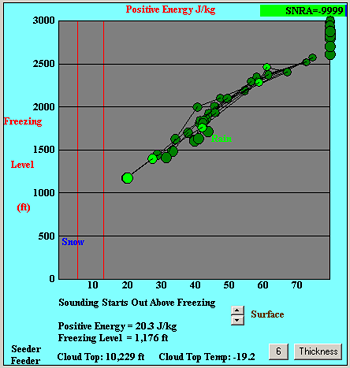

BUFKIT Bourgoiun Precipitation Type Analysis
For eWRF Ensembles for VNY at 8:00 am 02/26/11
The wetter ensemble member forecasts prevailed in last Friday's and Saturday's rain and snow event. Downtown Los Angeles recorded 1.20 inches for the storm. This brought the water year total to 15.78 inches, which is about 104% of normal. Although this might seem unusual in a La Nina influenced rain season, during two of the strongest La Ninas in the past 60 years -- 1955-56 and 1973-74 -- Los Angeles recorded 99% and 106% of normal rainfall. Here's an archived copy of a NWS tabulation of some rainfall totals from around the area from early Friday, February 25, to 10:00 p.m. Saturday, February 26.
The NAM and GFS, as well as the SREF and eWRF ensembles, had a tough time forecasting the rainfall produced by our current scenario -- a relatively shallow, moist westerly flow accompanied by modest jet stream dynamics. As this BUFKIT time-height cross section shows, the wettest eWRF ensemble member depicted a 125 kt jet max overhead, suggesting the models had some difficulty in forecasting the structure and strength of the jet. At best, the models forecast a few hundredths of an inch of rain in the Los Angeles area, but the most recent NWS tabulation of rainfall totals for the event lists many stations with between 0.1 and 0.25 inch. As of 4:00 a.m. this morning, Downtown Los Angeles has recorded 0.16 inches for the storm, bumping the water year total to 105% of normal.
As a result of the westerly flow, snow levels are currently high, but one of the interesting facets of last Friday's storm was the possibility of very low elevation snow. A NWS Winter Weather Advisory issued February 25 for the Santa Monica Mountains Recreation Area forecast the snow level to drop overnight from above 3000' to between 1000' and 1500'. Snow accumulations from 1 to 3 inches were expected. Some low elevation post frontal showers of graupel or snow were reported in the east San Fernando Valley and La Crescenta Saturday afternoon, but based on the conditions on Sandstone Peak (el. 3111'), the snow anticipated in the SMMRA did not occur. It was an especially challenging forecast, pitting pre-frontal warm air advection, against post-frontal cold air advection, falling humidity, and fluctuating regions of snow growth and omega.
Developed in part to help forecasters deal with lake effect snow, BUFKIT includes a number of special features for snow forecasting and visualization. For example, following are two time-height cross sections generated by BUFKIT from NAM data for VNY (Van Nuys) from 4:00 p.m. Friday, February 25. The elevation for the Bourgoiun precipitation type analysis for each cross section has been raised to 2711 feet MSL. The first BUFKIT cross section shows snow growth, omega, temperature, and the projected precipitation amount and type. The second cross section shows the same parameters, but with relative humidity instead of omega. The purple and yellow rectilinear contours are snow growth, and the red and blue contours are omega. The green bars are rain amounts, and the blue bars snow. Some of the things to note in these cross sections are the omega/snow growth "cross hair," freezing level, and rapid decrease in humidity with the frontal passage.
What the discrete NAM forecast can't show is the variability of the forecast situation. In its most recent release BUFKIT added support for SREF and eWRF ensembles. When combined with BUFKIT's precipitation type and other tools, ensemble forecasts can provide much additional information and insight. In this case eWRF ensemble members for VNY exhibited widely varying thermal profiles, regions of snow growth, omega, and humidity. BUFKIT's Bourgoiun precipitation type analysis for the eWRF ensemble members at 8:00 a.m. Saturday morning showed freezing levels as high as 2882' and as low as 1176'. The pattern of post-frontal precipitation was also quite variable.
More information concerning Southern California weather can be found using our WEATHER LINKS page.